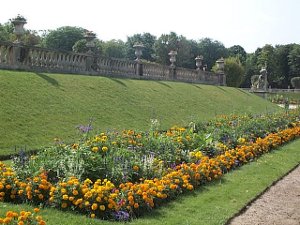 The organ at St. Sulpice
The organ at St. Sulpice
We had seen many museums and Famous Sights, it was almost time for Dan to leave for home, so we decided to spend our day on one last walk through parts of Paris. We headed to the left bank, taking the Metro to St. Sulpice station.
 The organ at St. Sulpice
The organ at St. Sulpice
We toured the church of St. Sulpice, but did not get to hear the magnificent organ. This church was started in 1635 but took 145 years to finish. We saw a representation of the Shroud of Turin and several fine chapels, one of which was decorated with murals by Delacroix.
The Palais du Luxembourg is the home of the French Senate, and we spoke of the weakness of that arm of the legislature, chosen from all the 35,000 communes by a political process that was not a direct democratic election. It remains curious to us how both the French and the English feel free to tinker with the structural parts of their government, perhaps unaware that new definitions of these structures will ripple through the fabric of their society.
The Palais du Luxembourg is surrounded by a tall iron fence and guarded by armed police, with some protections against terrorist attacks. The fence continues around a great park; palace and park were once a royal residence, but today the park is a well-used public garden, the Jardin du Luxembourg. It was filled with Saturday joggers and playing families. A grandstand had been set up behind the Senate building for an outdoor performance of The Marriage of Figaro. Each summer, Paris is host to numerous outdoor festivals of plays, concerts and opera. But because of the long summer days, the programs begin late at night. This opera didn't start until 11:30 and would finish at 2:30 in the morning without intermission. We decided this was for the younger crowd, but we contined to enjoy the gardens, with a pond and model sailboats, long walks, statuary, shrubbery and lovely flowers.
 Jardin du Luxembourg
Jardin du Luxembourg
We walked down the Rue Soufflot and past the Pantheon, and because our guide book listed this as something to miss, we did. It is an extensive cruciform building built in the style of a Greek temple and dedicated to French national heroes of the nineteenth century, now largely forgotten (or so says Rick Steves). From the outside we could verify the size and shape of the building, with traffic flowing around it in a circle.
Our walk took us past a house where Rene Descartes lived while in Paris; he was identified as mathematician and political counsellor. We continued past a lycee to an elementary school that was apparently celebrating the last day of the school year; the parents were there as the children brought home their models built in school and their papers. Dan appreciated his shorter school terms! Next to the gate was a marble plaque commemorating two of the students of that school who had been deported to Auschwitz and never returned.
We continued to Arenes de Lutece. This location was not even mentioned in our guidebook, but we found it on the map and investigated. It turns out to have been a first century Roman amphitheater, with a large central circle for contests between gladiators and animals. Some of the rows of seats still stand, so visitors can have a Colisseum-like experience. The central area looks like a great skateboard space. These Roman ruins and fragments exist throughout the city, with more appearing over the years as archaeological excavations take place. We were thrilled at the time warp which allowed one to walk a hundred feet away from a Parisian neighborhood back two thousand years into the world of Roman gladiators. We certainly recommend this sight, whether it's featured in the guidebooks or not.
 Bored ibexes
Bored ibexes
We kept on walking, this time to the botanical garden and menagerie. These attractions were disappointing for a city the size of Paris. There is another zoo located in the Bois de Vincennes; why don't the city fathers close this menagerie and combine the animals with the second zoo? Perhaps because the Bois de Vincennes is outside the city limits and the control of the powerful Mayor of Paris (who was formerly Jacques Chirac, now the French President.)
The botanical garden was free, the zoo charged 5 euros, and both of them needed to have a whole lot of money spent to bring them up to the standard we have seen in many other cities in Europe and America. We think the only conclusion is that neither of these facilities are important to Parisians, so there is no strong political pressure to improve them. The zoo, in particular, had a lot of old, dirty buildings in terrible repair, old fashioned cages, and a very small variety of animals. Since there were no rattlesnakes in the reptile building, we thought it might be appropriate for President Bush to send President Chirac a matched pair of Texas diamondback rattlesnakes as a state gift to ease the tensions between the two countries!!
Despite the shabby surroundings, we enjoyed seeing some of the birds and larger animals, and were impressed by perhaps the largest ostrich we have ever seen.